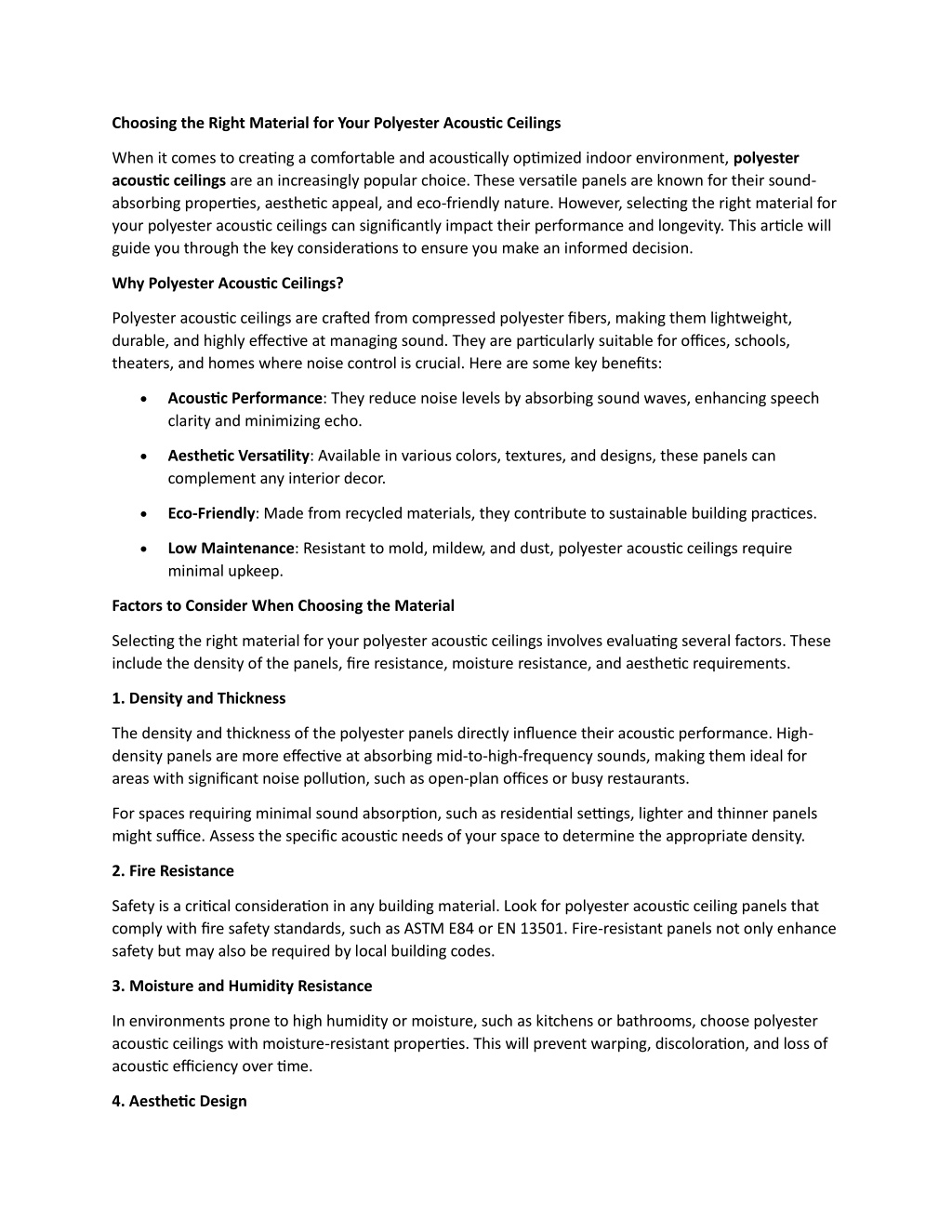
Choosing the Right Material for Your Polyester Acoustic Ceilings
When it comes to creating a comfortable and acoustically optimized indoor environment, polyester acoustic ceilings are an increasingly popular choice. These versatile panels are known for their sound-absorbing properties, aesthetic appeal, and eco-fr
Download Presentation

Please find below an Image/Link to download the presentation.
The content on the website is provided AS IS for your information and personal use only. It may not be sold, licensed, or shared on other websites without obtaining consent from the author. Download presentation by click this link. If you encounter any issues during the download, it is possible that the publisher has removed the file from their server.
E N D
Presentation Transcript
Choosing the Right Material for Your Polyester Acoustic Ceilings When it comes to creating a comfortable and acoustically optimized indoor environment, polyester acoustic ceilings are an increasingly popular choice. These versatile panels are known for their sound- absorbing properties, aesthetic appeal, and eco-friendly nature. However, selecting the right material for your polyester acoustic ceilings can significantly impact their performance and longevity. This article will guide you through the key considerations to ensure you make an informed decision. Why Polyester Acoustic Ceilings? Polyester acoustic ceilings are crafted from compressed polyester fibers, making them lightweight, durable, and highly effective at managing sound. They are particularly suitable for offices, schools, theaters, and homes where noise control is crucial. Here are some key benefits: Acoustic Performance: They reduce noise levels by absorbing sound waves, enhancing speech clarity and minimizing echo. Aesthetic Versatility: Available in various colors, textures, and designs, these panels can complement any interior decor. Eco-Friendly: Made from recycled materials, they contribute to sustainable building practices. Low Maintenance: Resistant to mold, mildew, and dust, polyester acoustic ceilings require minimal upkeep. Factors to Consider When Choosing the Material Selecting the right material for your polyester acoustic ceilings involves evaluating several factors. These include the density of the panels, fire resistance, moisture resistance, and aesthetic requirements. 1. Density and Thickness The density and thickness of the polyester panels directly influence their acoustic performance. High- density panels are more effective at absorbing mid-to-high-frequency sounds, making them ideal for areas with significant noise pollution, such as open-plan offices or busy restaurants. For spaces requiring minimal sound absorption, such as residential settings, lighter and thinner panels might suffice. Assess the specific acoustic needs of your space to determine the appropriate density. 2. Fire Resistance Safety is a critical consideration in any building material. Look for polyester acoustic ceiling panels that comply with fire safety standards, such as ASTM E84 or EN 13501. Fire-resistant panels not only enhance safety but may also be required by local building codes. 3. Moisture and Humidity Resistance In environments prone to high humidity or moisture, such as kitchens or bathrooms, choose polyester acoustic ceilings with moisture-resistant properties. This will prevent warping, discoloration, and loss of acoustic efficiency over time. 4. Aesthetic Design
Polyester acoustic ceilings offer a wide range of design possibilities. Whether you prefer a subtle finish or a bold statement, consider: Color Options: Neutral tones for professional settings or vibrant colors for creative spaces. Textures and Patterns: Smooth finishes for modern interiors or textured designs for added character. Custom Shapes: Panels can be cut into unique shapes to create dynamic visual effects. Selecting a design that aligns with your overall decor will ensure the ceilings enhance the aesthetic appeal of your space. 5. Environmental Impact Sustainability is a growing priority in construction and interior design. Opt for polyester acoustic ceilings made from recycled materials and those certified by eco-friendly organizations such as LEED or GreenGuard. These certifications indicate a lower environmental footprint and adherence to green building standards. 6. Ease of Installation Ease of installation is another important factor. Lightweight panels are easier to handle and install, reducing labor costs and project timelines. Additionally, panels with pre-cut designs or modular systems can further simplify the installation process. Tips for Optimal Performance To maximize the benefits of your polyester acoustic ceilings, consider these tips: Combine with Other Acoustic Elements: Pair ceiling panels with wall-mounted acoustic panels or carpets to enhance sound absorption. Strategic Placement: Install panels in areas where sound reflection is most problematic, such as ceilings above meeting areas or workstations. Regular Maintenance: While polyester panels require minimal upkeep, occasional cleaning with a soft cloth or vacuum can maintain their appearance and efficiency. Popular Applications Polyester acoustic ceilings are suitable for a wide range of applications, including: Corporate Offices: Enhance productivity by minimizing distractions in open-plan workspaces. Educational Institutions: Improve acoustics in classrooms, libraries, and lecture halls to support learning. Healthcare Facilities: Create calming environments by reducing noise in waiting rooms and patient areas. Residential Spaces: Enhance comfort in home theaters, living rooms, and bedrooms.
Hospitality Settings: Elevate the guest experience by controlling noise in restaurants, hotels, and event venues. Conclusion Choosing the right material for your polyester acoustic ceilings is essential to achieving optimal acoustic performance and aesthetic appeal. By considering factors such as density, fire resistance, moisture resistance, and design preferences, you can ensure your investment meets the unique needs of your space. Polyester acoustic ceilings not only enhance sound quality but also contribute to a sustainable and visually appealing environment. Whether you re designing a modern office or a cozy home, selecting the right panels will make a lasting difference in the functionality and beauty of your space.






















